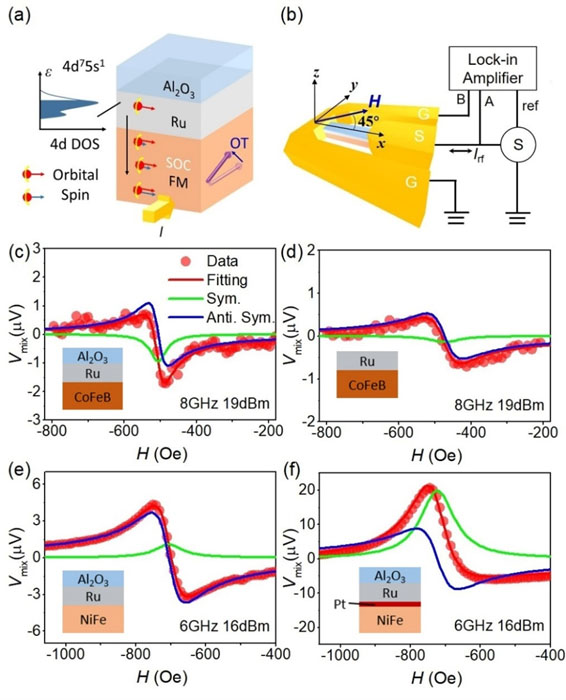Orbital Torque in Ferromagnetic-Metal/Ru/Al2O3 Trilayers
Otani Group
For the development of spintronic memory and logic devices, the efficient current-induced spin-torque effect is critical. Spin-orbit torque, which uses spin-orbit coupling (SOC) in heavy metals (and/or Rashba interfaces) to create spin current and resulting torque to switch the magnetization of a neighboring ferromagnetic layer, has received a lot of attention in the last decade. The torque effect based on orbital angular momentum injection and SOC in the ferromagnet, known as orbital torque (OT), has recently attracted much attention. While each electronic state in a spin current may only carry ħ/2 angular momentum, the angular momentum carried by a state in an orbital current has no limit, implying that OT has higher efficiency. Indeed, in most metal elements, orbital-current production efficiency is substantially higher than its spin equivalent. Furthermore, because SOC is not required, the materials choices for the orbital source are pretty broad, rather than being confined to a few types of heavy metals like spin-current generation. As a result, OT is a strong contender for the operating principle of practical spintronic devices.
The development of OT devices based on polycrystalline stacks is beneficial for industrial on-silicon manufacture. OT was previously discovered primarily due to the interfacial orbital Rashba effect (ORE) in polycrystalline layered structures grown by room-temperature evaporation or sputtering, which can modulate OT through layer design. These studies use an interface or a bulk containing Cu or Pt as a source of orbital angular momentum. The full d-shell of Cu and the high SOC of Pt obstruct orbital transport and make OT analysis in polycrystalline stacks more difficult. Oxidation helps orbital transport in Cu, adding complexity to the structure. Meanwhile, theoretical works have focused on the orbital generation and transport in single-crystalline systems because of the complexity of orbital transport in polycrystalline heterostructures. It is highly warranted to bridge the gap between experiment and theory by obtaining efficient, long-range orbital transport in a uniform polycrystalline layer and developing a corresponding theoretical approach to orbital transport that remains elusive.
We experimentally study the current induced torque effect in polycrystalline ferromagnetic metal (FM)/Ru/Al2O3 stacks shown in Fig. 1(a). FM is either Co40Fe40B20 or Ni80Fe20. Using a device structure, we demonstrate a high torque efficiency due to the ORE at the Ru/Al2O3 interface (Fig. 1(b)). Ru is chosen because of its electronic configuration of 4d75s1 and a small bulk-originating spin-orbit torque so that orbital-current generation is allowed by orbital hybridization; the absence of d-electrons does not limit orbital-current propagation at the Fermi level or SOC-related relaxation, and OT is not disturbed by the conventional spin Hall torque. We performed spin-torque ferromagnetic resonance (ST-FMR) measurements (Fig. 1(b)) on the polycrystalline FM/Ru/Al2O3 stacks. Figure 1(c) shows the Vmix signal obtained from the ST-FMR measurement of a Co40Fe40B20(7)/Ru(6)/Al2O3(2) (units in nanometers) trilayer. The signal Vmix is decomposed into symmetric (S) and asymmetric (A) Lorentzian components, revealing sizable negative S components that indicates the current-induced damping-like torque. From systematic studies in this work, we find characteristic behaviors of OT: (i) the sign and magnitude of the torque efficiency are strongly dependent on the FM materials and insertion layers according to the sign and magnitude of their SOC (Fig. 1(c) and (e)); and (ii) torque efficiency is enhanced with increasing CoFeB layer thickness tF, with a large saturation torque efficiency of 0.3 for tF = 12 nm, consistent with the long propagation length of the orbital current in the ferromagnet. Our quantum evolution simulation shows the unique random processing feature of orbital transport in polycrystalline materials, enabling long-range orbital transport in polycrystalline samples, even in a crystal field.

Fig. 1. (a) Schematic of the orbital torque in FM/Ru/Al2O3. (b) Experimental setup of the ST-FMR measurement. (c)–(f) ST-FMR spectra and fitting for the CoFeB(7)/Ru(6)/Al2O3(2) (c) and CoFeB(7)/Ru(6) (d) devices at 8 GHz, and NiFe(7)/Ru(6)/Al2O3(2) (e) and NiFe(7)/Pt(1)/Ru(6)/Al2O3(2) (f) devices at 6 GHz. The red circles are experimental data; the red lines are fitting curves. The symmetric and antisymmetric components plots are in the right panel with green and blue lines. Schematics of the sample layout are shown in the inset.
This study concludes that transition metal-based materials with a small SOC, simple structure, and itinerant d-electrons can provide a suitable platform for studying orbital transport in polycrystalline structures and developing torque devices.
References
- [1] L. Liao, F. Xue, L. Han, J. Kim, R. Zhang, L. Li, J. Liu, X. Kou, C. Song, F. Pan, and Y. Otani, Phs. Rev. B 105, 104434 (2022).
